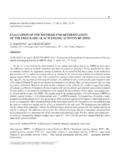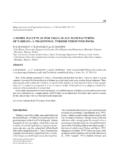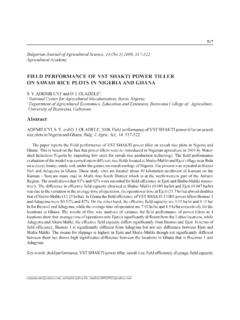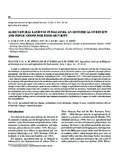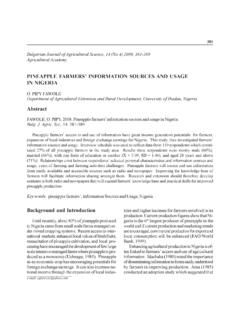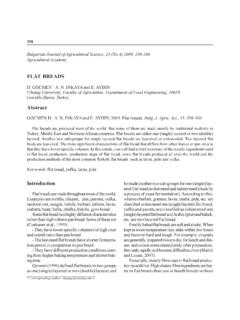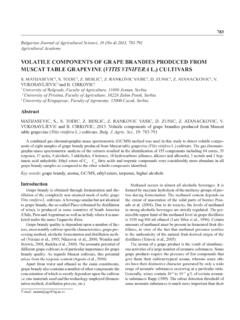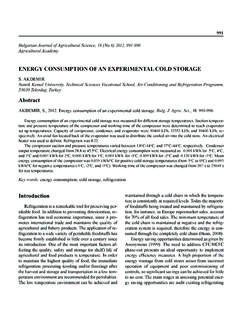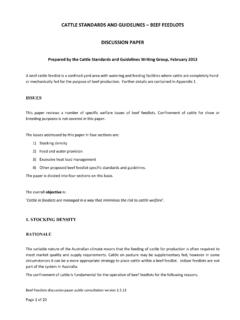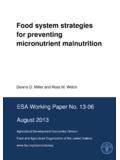Transcription of INFLUENCE OF STOCKING DENSITY ON THE …
1 150 Bulgarian Journal of Agricultural Science, 14 (No 2) 2008, 150-154 National Centre for Agrarian SciencesINFLUENCE OF STOCKING DENSITY ON THE GROWTHPERFORMANCE OF RAINBOW TROUT AND BROWN TROUTGROWN IN RECIRCULATION SYSTEMI. SIRAKOV and E. IVANCHEVAA gricultural Faculty, Thracian University, BG - 6000 Stara Zagora, BulgariaAbstractSIRAKOV, I. and E. IVANCHEVA, 2008. INFLUENCE of STOCKING DENSITY on the growth performance of rain-bow trout and brown trout grown in recirculation system. Bulg. J. Agric. Sci., 14: 150-154 Rainbow trout with initial weight g and brown trout with initial weight were grownin two STOCKING DENSITY 1 - 29 and STOCKING DENSITY 2 - 57 Survival of fish was higherat lower DENSITY . The growth was significantly reduced at high DENSITY (P< for rainbow trout and P< forbrown trout).
2 Feed conversion ratio was favorable in tanks at low rearing DENSITY for two trout species (P< ).The INFLUENCE of STOCKING DENSITY on growth and feeding ratio was higher at brown trout compared with words: rainbow trout, brown trout, STOCKING DENSITY , survival, growth, FCRA bbreviation: SD STOCKING DENSITY ; FCR - feed conversion ratioe-mail: scientists considered that in intensiveaquaculture fish were kept at too high densities. Highstocking densities can have a detrimental impact onthe health and welfare of rainbow trout as well. Inparticular, high densities can lead to: increased stress (Wall, 2000; H stein, 2004) increased susceptibility to disease (EuropeanCommission, 2004) increased incidence of physical injuries (Juell etal., 2003; Turnbull et al., 2005; North et al., 2006) poor body condition (Ellis et al.)
3 , 2002) reduced growth, feed intake and feed conver-sion efficiency (Ellis et al., 2002)Ellis et al. (2002) reviewed the scientific literatureconcerning the relationship between STOCKING densityand welfare in farmed rainbow trout. These authorsexamined 43 papers that studied the effects of stock-ing DENSITY on productivity, health, body condition andstress level. They found that commonly reported ef-fects of increasing STOCKING DENSITY include an increasein fin erosion and reductions in growth, feed intake,feed conversion efficiency plus body and liver condi-tion. They concluded that such changes are indicativeof a reduced welfare authors proved INFLUENCE on STOCKING den-sity on the welfare of trout fish which affects survival,growth and feeding ratio, but the dates of these stud-ies were recommended STOCKING DENSITY in our countryfor intensive cultivation of rainbow trout is between80 100 (Zaikov, 2006).
4 In Bulgariathere are researchers who have investigated the influ-ence of stock DENSITY on trout grown in cages, butpublications concerning that problem are almost miss-ing on the cultivation of trout in a recirculation purpose of this research was to investigatethe INFLUENCE of STOCKING DENSITY on surviving, growthintensity and FCR of the rainbow trout and browntrout cultivated in a recirculation and MethodsThe experiment was carried out in a 42 days pe-riod. It was conducted in the experimental base ofaquaculture Agricultural Faculty, Thracian Univer-sity. For the trial were used 8 tanks conducted to re-circulation system. The size of the tanks was 1/1/1 m,with working capacity of m3. Recirculated waterwas rectified by mechanical and biological filters. Freshwater was added once a day when the tanks average size of fish at the start of the experi-ment was: rainbow trout g brown trout gBoth fish species were randomly distributed in twoexperimental groups with two replications each of them(Figure 1): STOCKING DENSITY 1 (SD1) 29 STOCKING DENSITY 2 (SD2) 57 were fed by hand with extruded pellets, 4times a day.
5 Table 1 show the diets used in these size of the pellets was 2 mm. The daily ratiowas specified as a percent of the whole biomass atdifferent densities. The feed consumption was re-corded every day and at the end of the trial the FCRwas whole quantity of fish in different DENSITY atthe start of the experiment was weighed. At the endof the trial 15 fish from each DENSITY were protein 44 Crude g-1vit E176 of used foodTable 1water pumpBilogical filterMechanical filterSD2 Brown troutSD1 Brown troutSD2 Rainbow troutSD1 Rainbow troutSD2 Brown troutSD1 Brown troutSD2 Rainbow troutSD1 Rainbow troutFig. 1. Scheme of the experiment151 INFLUENCE of STOCKING DENSITY on the Growth Performance of Rainbow Trout and Brown Trout troutbrown troutDuring the experiment hydro chemical parameterswere measured: temperature (C ), oxygen (mg ), ammonia, nitrite and nitrate ( ).
6 They weremeasured according to generally accepted the end of the experiment were calculated: fish survival (%) body weight (g) individual growth rate (g) weight gain (g) relative weight gain - % food conversion ratioAll the data was analyzed by descriptive statisticsand single factor ANOVA, describing the effects and DiscussionWater temperature ranged from - Cduring the trial period. Oxygen concentration in watervaried between 8 and 9 mg Ammonia was notfound, nitrites and nitrates varied respectively and 8 10 survival was higher in SD1 comparedto that in SD2 for the two cultivated species but thisdifference was not a significant evidence of influenceof this indicator on the examined body weights of the two trout speciesdidn t show differences at the start of the trial (Table2).In the recirculation system, at the end of the 42days trial period the final weight of rainbow trout atSD1 was g higher than that of the trout from thelowest STOCKING DENSITY (Table 2).
7 This tendency of average final body weight to de-crease with the increasing of STOCKING DENSITY was validfor the trial of brown trout too. The advantage in finalbody weight was on the hand of trout from low stock-ing DENSITY (Table 2).Average individual growth rate of rainbow troutfrom SD1 was higher with higher than that oftrout of high STOCKING DENSITY and for the brown troutthis difference was % (Table 3).In our trial the INFLUENCE of STOCKING DENSITY toweight gain was better manifested in brown trout thanin rainbow trout. The brown trout from SD1 had % higher weight gain than that of the fishes fromSD2. This difference in weight gain of rainbow troutbetween the 2 densities was % (Table 3).SD1SD2SD1SD2x Sx Sx troutP> < of trialend of trialTable 2 Start of trialEnd of trialP> < weights (g) of rainbow trout and brown trout Rainbow troutFig.
8 2. Relative weight gain of rainbow troutand brown trout152I. Sirakov and E. IvanchevBrown trout from SD1 had an % higher rela-tive weight gain than fish from lower STOCKING situation with rainbow trout was the same, butthe difference was just % to the advantage of thetrout from SD1 (Figure 2).The INFLUENCE of STOCKING DENSITY on average val-ues of feed conversion ratio was significantly mani-fested in brown trout. The fish from SD2 had a FCR compared to brown trout from SD1(P< ). This difference in rainbow trout was sig-nificantly too but just 9 % to the advantage of FCR oftrout from the lowest STOCKING DENSITY (P< ).The temperature at the time of our trial was in op-timal borders for the two cultivated species. Ammo-nia and nitrites had optimal values for the cultivatedfish, but nitrates had high rates, because recirculationsystem we use does not have a denitrification blockthat would have decreased high nitrate is a key indicator of health status.
9 Fishsurvival was high in our trial, but the differences werenot significant evidence that surviving of trout is af-fected by STOCKING DENSITY . Wallat et al. (2004) re-ported that average survival was for the lowdensity and % for the high DENSITY for trout cul-tivation in cages. Bircan (1997) obtained similar toour data for trout survival in his trial. Some studiesshowed opposite results to those obtained by us, highsurvival of trout cultivated at high STOCKING DENSITY indifferences at low STOCKING DENSITY in which fish sur-vival was lower (North et all., 2003).Many authors (Bojard et al., 2002; Melotti et al.,2004; Wallat et al., 2004; Rasmussen et al., 2007)remarked the INFLUENCE of STOCKING DENSITY on thegrowth of trout. Reduced growth and an increase foodconversion ratio with the increasing of STOCKING den-sity were found in 70% of the studies investigated byEllis (2002).
10 Rainbow trout growth and feeding ratiowas better at low STOCKING DENSITY compared to thegrowth and feeding ratio of fish at high STOCKING den-sity in our trial. Brown trout in our study showed higherdifferences of growth and feeding ratio at the exam-ined DENSITY than these of rainbow trout to the advan-tage of fish at low STOCKING DENSITY too. Some studiesreported that high densities lead to aggression and somewelfare problems that authors suggest may be due tothe existence of a dominance hierarchy (North et al.,2006). We didn t investigate the behavior of cultivatedfish species especially, but when we observed themwe didn t see so many cases of aggression and weconsidered that the general reason for high survival,growth and feeding ratio in tanks at low DENSITY is aresult of better quality of the water in them. Ellis et al.
